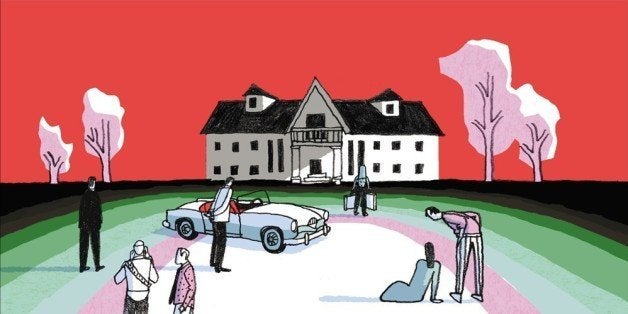
The Hundred-Year House
by Rebecca Makkai
Viking Adult, $26.95
Published July 10, 2014
The Book We're Talking About is a weekly review combining plot description and analysis with fun tidbits about the book.
What we think:
Fictional estates -- Henry James’s Bly, Daphne du Maurier’s Manderly -- have long served as more than confined settings for plots to unravel in. Like characters, they’re given names, and serve as catalysts for action. Unlike most characters, they don’t typically exhibit a capacity for change. They are concrete reminders of the fixed, often haunting past.
Stately standing at the center of Rebecca Makkai’s latest novel The Hundred-Year House is Laurelfield, a secret-ridden mansion that once served as an arts colony. We're first introduced to its most recent inhabitants: Zee, whose esteemed Marxist Studies curriculum has recently been shaken up by the opportunity to teach a summer course on ghost stories; her husband, Doug, whose attempt to pen a tenure track-earning monograph on poet Edwin Parfitt has been put on hold for a Babysitter's Club-like writing gig; Gracie Devohr, Zee’s mother who bears a striking and hilarious resemblance to Lucille Bluth; Gracie’s husband Bruce and his son Case; and Miriam, an off-kilter collage artist from Texas.
When we meet the bumbling crew they are, among other silly exploits, preparing for Y2K by stocking up on preserved food, and, for some reason, purchasing a Chevy. But “the ball came down, and the world did not end,” and the disjointed family is left to consider that the “millennium bullshit” has clouded their awareness that the year 2000 also marked the end of a century. While cerebral Zee considers the 1900s to be “the worst century... in all human history,” whimsical Miriam acknowledges the good that came of it (“... all the art... And jazz, and movies!”).
Miriam’s optimism is apparent in the art she creates. She repurposes found materials into cohesive, if not objectively beautiful, arrangements. Her outlook is infectious to Doug, who willfully falls in love with her, and is in keeping with the philosophy of many of the houses’ inhabitants: Transformation is beautiful, and necessary for survival.
Zee grew up on stories of revival: Actaeon, Philomela and Daphne, who is mentioned in the book’s epigraph, a quote from Ovid’s Metamorphoses. Her parents raised her on anecdotes of their own transformations (although, as we read on, we realize that some were fictionalized or under exaggerated). Her father, for example, said to have reinvented himself, “from alcoholic slouch to art critic.” But, as several characters throughout the course of the novel demonstrate, reinventing oneself seems an impossible task when the house, with its dark crevices containing irrefutable historical archives, looms over each scene.
The true stories behind the house’s mythical former residents are eventually revealed, as Makkai expertly lurches back in time to 1955, to its artist residency days in the '20s, and finally to its conception in 1900. Edwin Parfitt (the subject of Doug’s biography) was a poet-in-residence at Laurelfield, and his pessimism while living there is congruous with that of its modern-day inhabitants. He leaves abruptly, claiming the place has made his poetry darker, and that he must start anew elsewhere. His fellow residents seem bogged down by the atmosphere as well –- one remarks, “There’s no love, only history.”
His desire to escape the confines of such a massive, inescapably literal structure is foreshadowed (or followed, depending on which timeline you’re adhering to) by Zee, who realizes “she had never been a hardboiled egg but a raw one… When that shell cracked, what else could a raw egg do but run?” before fleeing Laurelfield.
Makkai’s clever choice to chronicle the house’s history in reverse exposes the flimsiness of perceived facts, and their simultaneous ability to stifle arguably truer stories. She weaves an intricate web of myths, and although she slowly reveals which are rooted in reality, she also shows us that such knowledge might be irrelevant.
What other reviewers think:
NPR: "The Hundred-Year House may be crowded with the tropes and tricks of classic horror, but make no mistake: It's not a horror story. Rebecca Makkai's style, a patchwork of ambition and aw-shucks charm, lets in just enough sunlight to scatter those things that go bump in the night."
The Boston Globe: "Makkai’s lyrical prose quietly lifts off the page while her carefully crafted plot charges forward. Narratively, it’s a precarious balance that could easily tip at any moment into contrivance or melodrama, but neither occurs as this author strikes a perfect equilibrium of dark humor and tragedy."
Los Angeles Times: "The Hundred Year House is a big-hearted gothic novel, an intergenerational mystery, a story of heartbreak and a romance, all crammed into one grand Midwestern estate."
Who wrote it?
Rebecca Makkai is the author of The Borrower. This is her second novel.
Who will read it?
Fans of family sagas, funny stories, and gothic tales.
Opening lines:
"For a ghost story, the tale of Violet Saville Devohr was vague and underwhelming. She had lived, she was unhappy, and she died by her own hand somewhere in that vast house. If the house hadn't been a mansion, if the death hadn't been a suicide, if Violet Devohr's dark, refined beauty hadn't smoldered down from that massive oil portrait, it wouldn't have been a ghost story at all."
Notable passage:
"Doug had started to see the world as reticulated. The way the colored pieces of any view fit together: windowsill, wall, sky, driveway, tree, roof. Shoe, carpet, book. If you looked long enough, the three-dimensional world flattened to a plane where every block of color was a tile, so tightly clicked together that no mortar showed through the cracks."
Rating, out of ten:
8. Makkai humorously turns the conventional family saga on its head, in a clever exploration of metamorphosis and secrecy.
